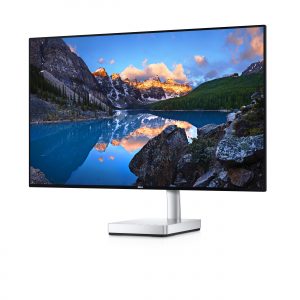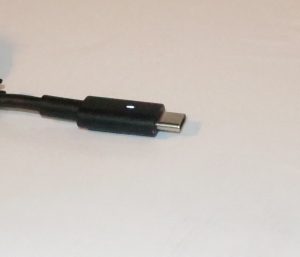Article

Dell’s slimline 27″ monitor with its electronics in its base is an example of a USB-C monitor
Best USB-C Monitors for PC in 2019 | Windows Central
My Comments
An increasing number of standalone display monitors are becoming equipped with the USB-C connection as a path for connecting your computer to them.
This connection works uses the DisplayPort alt path offered by the connection standard for video transfer from the host computer as a minimum feature. This is part of the USB-C standard that allows different host-peripheral connection paths like DisplayPort to be run via the same physical cable along with the USB-based host-peripheral data transfer. But most of these monitors will support being a power source compliant to the USB Power Delivery device class so they can provide power to and charge a laptop that is connected to them as a host. Better implementations of this standard will even support being their own powered USB 3.x hub and have two or three traditional USB 3.0 ports.

These USB-C plugs are now another connection path for linking your computer to a display monitor
There will be at least some HDMI or standard DisplayPort input connections for legacy setups such as desktop or laptop computers that don’t come with USB Type-C connections. But you can exploit the hub functionality in those monitors that implement it if you use a USB cable that has a Type C connector on one end and a traditional Type A connector on the other end.
If the monitor has any sort of audio functionality, this will be facilitated through the DisplayPort or HDMI connections. In the case of the USB-C setup, the sound will be transferred using the DisplayPort alt ability that this connection provides. Most of the monitors with this function will have a 3.5mm stereo audio-output jack that can work to headphone or line-out specifications and may have integral speakers.
You will need to have your computer use the “display audio” driver rather than its audio chipset to use the monitor’s audio abilities via the USB-C, DisplayPort or HDMI connections. As well, don’t expect much in sound quality from the integral speakers and it may be a better idea to use a set of good active speakers or your favourite stereo setup for the sound.
Like with monitors that don’t come with the USB-C connection, buying a USB-C monitor will be more of a “horses for courses” approach. Here you will come across 4K UHDTV screens with wide colour gamut and HDR support which will come in handy if you engage in photo or video editing. This is while there will be monitors optimised to work with the latest high-performance discrete display subsystems for those of us who like playing the latest high-end games.
Another question that will come up if your computer has a Thunderbolt 3 output is how these screens will fit in with external graphics modules that you may use. Most of these modules will require you to connect their video output to the monitor’s HDMI or DisplayPort connections as if you are connecting a legacy host computer but some may use a secondary Thunderbolt 3 / USB-C connection to allow you to connect your USB-C monitor with its video coming from the module’s graphics infrastructure.
Use Cases
One main use case would be for those of us who have a laptop-based working environment. Here, you would use a USB-C monitor with integrated hub functionality and connect your wired peripherals to the monitor while your laptop is connected to your monitor using one cable. You then end up dealing with just one cable when you bring your computer to or remove it from that workspace.
Another main use case is if you are dealing with a “next unit of computing” midget computer or other small-form-factor computer that implements this connection type. Where manufacturers see the USB-C connection type as a way to reduce the computer’s size, these monitors can earn their keep as a preferred display type for these systems.
Do I need to replace my existing monitor for one with a USB-C connection
At the moment, you don’t need to replace your existing monitor with one that has a USB-C connection if your existing monitor serves your needs well. This is more important for those of us who have existing computer equipment that isn’t equipped with this connection or aren’t buying equipment that will have this connection.
But if you are replacing an existing monitor with something that better suits your needs or adding one to a multiple-display setup, this connection type can be a valid feature to be aware of when comparing the feature lists of each candidate unit. Here, it will be about having one that is future-proof especially when you use computer equipment that has this connection type.
What to look for
Make sure the monitor you are after has the display size, aspect ration and other abilities that suit your key usage scenario. For example, gamers should look for monitors that work tightly with their preferred high-performance graphics cards.
Look for a USB-C monitor that has a USB hub with plenty of USB 3.0 downstream connections. Another USB-C downstream connection can be an asset worth considering. But at least one of the USB sockets must be easily discoverable and accessible from your operating position.
The USB-C monitor should have be able to work as a power source compliant to the USB Power Delivery specification with an output of 45 watts or more. This will mean that you don’t need to use your laptop computer’s battery charger to run your laptop at home or work.
Audio-equipped USB-C monitors must have an external line-level or headphone audio output so you can use them with your favourite audio devices.
If the monitor has an integrated Webcam, it may be an asset for your privacy to have a user-operated shutter across the camera lens or the Webcam to be of a “pop-up” design that is concealed when not in use.
Conclusion
Over this year, the appearance of display monitors with a USB-C connection will become more common as the number of laptop and small-profile computers kitted out with this or the Thunderbolt 3 connection increases.


